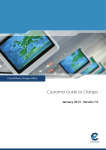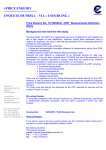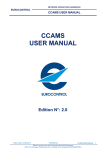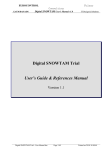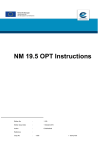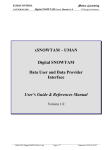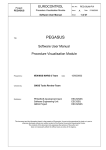Download MTOW
Transcript
The Mission of EUROCONTROL’s Central Route Charges Office (CRCO) The Central Route Charges Office (CRCO) runs an efficient system for the cost recovery of air traffic services provided to airspace users. On behalf of EUROCONTROL’s Member States, the CRCO establishes bills and collects charges levied on aircraft operators using en-route air navigation facilities and services. The EUROCONTROL Route Charges System is a regional cost-recovery system that funds air navigation facilities and services and supports Air Traffic Management developments. It is operated by the CRCO in Brussels in a very cost-efficient way, with low collection costs (less than 0.3%) and a high recovery rate (more than 99%).Each operator receives a single bill in EURO, no matter how many States were overflown. The CRCO also bills and collects terminal charges (for Member States) and air navigation charges (for non-Member States) on a bilateral basis. (See parts B and C of this guide). This cost-recovery system is indispensable in ensuring that air navigation facilities and services are steadily financed and safely operated. It also helps pave the way for the future evolution of the pan-European Air Traffic Management (ATM) system, in the context of the Single European Sky and the European ATM Master Plan (SESAR). January 2013 Page 2 The purpose of this booklet is to provide information on the different charges levied by the CRCO. The billing and methods of establishing the charges EUROCONTROL Member States and non-Member States. are explained for both The basic billing documents are described and information is supplied on methods of payment and the submission of claims. Please note that this booklet is updated regularly (at least once a year or whenever major changes occur) and that changes from the previous version will be shown in red. The CRCO pages on EUROCONTROL’s public website (http://www.eurocontrol.int/crco) give a great deal of useful information and contain the latest updates of all items featured in this document. FRAUD WARNING! Fraudsters frequently attempt to make airlines pay into false bank accounts. The fraudsters contact airlines by e-mail or telephone, claiming that EUROCONTROL bank accounts have changed and try to persuade airlines to make payments to fake bank accounts. Treat any e-mail with suspicion! In case of doubt, immediately ring phone number: +32.2.729.38.38. We never communicate changes to our bank accounts by mail, e-mail, fax or by telephone. Details of the bank accounts which airlines should use for their payments are indicated on official EUROCONTROL Bills and Statement of Accounts, printed on secured, watermarked paper bearing our logo, and sent to airlines by post. Always pay EUROCONTROL bills into these EUROCONTROL bank accounts. Under no circumstances should users pay into any bank account other than those printed on the official EUROCONTROL documents. Never accept any other source of information. If in doubt, ring phone number: +32.2.729.38.38. For increased security, airspace users should use our secured extranet system CEFA to download their billing documents and to consult their account’s latest status. This facility is entirely free of charge and allows airspace users to download billing documents in PDF format and to consult their financial situation. Users can also submit claims and monitor their status (for claims against en-route charges. See also part A.7.). They can also look up and submit modifications of aircraft data. (See also part A.4.) Therefore, we strongly advise all users to use this CEFA extranet service. All details on the CEFA extranet can be found on the CRCO pages of EUROCONTROL’s public website: (http://www.eurocontrol.int/crco/public/standard_page/cefa_presentation.html). January 2013 Page 3 How to join and use CEFA? The airspace user has to sign a service agreement with the CRCO in order to join CEFA, the secured extranet. This service agreement, as well as the CEFA User Manual and other useful information, are available on the CRCO pages of EUROCONTROL’s public website: (http://www.eurocontrol.int/crco/public/standard_page/cefa_presentation.html). The service agreement should be filled out, signed and returned to the following e-mail address: [email protected]. Two weeks after receiving this document, the CRCO will grant the user access to CEFA and send all the information needed to connect to CEFA, such as login ID and a password. There is also a CEFA Helpdesk for users: EUROCONTROL Central Route Charges Office Rue de la Fusée 96 B – 1130 Brussels Belgium Email: Phone: Fax: [email protected] +32 2 729 3838 +32 2 729 9093 January 2013 Page 4 Part A. En-route charges A.1 Introduction The EUROCONTROL Member States have adopted the basic principles for a harmonised regional en-route charges system, involving a single charge per flight. The CRCO operates this system on behalf of States with due regard to the guidelines recommended by the International Civil Aviation Organisation (ICAO), in particular those concerning equity and transparency. States, both current and future, who participate in the Route Charges system are:Albania (LA) Germany (ED) Norway (EN) Armenia (UD) Georgia (UG)(01/05/2013) Poland (EP) Austria (LO) Greece (LG) Portugal (LP & AZ) Belgium (EB) Hungary (LH) Romania (LR) Bosnia-Herzegovina (LQ) Italy (LI) Serbia (LY) Bulgaria (LB) Latvia (EV) Slovak Republic (LZ) Croatia (LD) Lithuania (EY) Slovenia (LJ) Cyprus (LC) Luxembourg (EL) Spain (LE & GC) Czech Republic (LK) Malta (LM) Sweden (ES) Denmark (EK) Moldova (LU) Switzerland (LS) Finland (EF) Monaco (LN) Turkey (LT) France (LF) Montenegro (LY) Ukraine (UK)1 FYROM (LW) Netherlands (EH) United Kingdom (EG) Ireland (EI) Bills for EUROCONTROL’s route charges are sent out monthly: bills are sent out in the middle of the month following the month in which the flights took place. A calendar with the billing dates can be found on the CRCO pages of EUROCONTROL’s public website: http://publish.eurocontrol.int/articles/information-circulars 1 Ukraine is a EUROCONTROL Member State but not yet technically integrated January 2013 Page 5 A.2 Flight data used for billing The Member States supply the basic data required for calculating the route charges and are responsible for the accuracy of this data. The State responsible for collecting and sending the flight data is the State of the aerodrome of departure, or via whose airspace the aircraft first enters the EUROCONTROL charging area. The route description per flight is extracted from the flight plan filed by the operator and approved by the Central Flow Management Unit (CFMU) 30 minutes prior to take-off. This enables the CRCO to calculate the distances flown in each State’s airspace. The Filed Flight Plan: “The operator shall ensure prior to operation of the flight that the content of the initial flight plan correctly reflects the operational intentions.” “The operator shall ensure that the conditions of acceptance of a flight plan and any necessary changes thereto as notified by IFPS to the originator are incorporated into the planned flight operation and communicated to the pilot.” Source: Commission Regulation (EC) No 1033/2006 laying down the requirements on procedures for flight plans in the pre-flight phase for the Single European Sky, applicable as from 1 January 2009. A.3 Liability for charges A charge has to be levied for each flight in the EUROCONTROL airspace. This airspace is divided into en-route Charging Zones as defined by the contracting States. The person/company liable to pay the charge shall be the person/company who was the operator at the time the flight was performed. If the identity of the operator is not known, the owner of the aircraft shall be regarded as the operator unless he proves that another person/company was the operator. The operator is identified: a) By the ICAO designator entered in field 7 of the flight plan, if the airspace user has one. Airspace users should not use ICAO designators that have not been officially allocated to them. b) By the Aircraft registration entered in field 7 of the flight plan, in other cases. Airspace users are invited to communicate their administrative and billing address, their AOC (Aircraft Operator’s Certificate), their Value Added Tax (VAT) status (including their VAT number) and all useful contact details to [email protected]. Users connected to CEFA (see pages 3-4) can update this information online. When the details change, users are invited to update their information immediately in order to avoid any delay that could eventually generate interest on late payment. Airspace users wishing to rely on Handling Agencies for the payment of their charges should request the CRCO to indicate the address of the handling agent as their billing address (with the mention “care of”). January 2013 Page 6 Charges generated in a Charging Zone may be subject to Value Added Tax (VAT). EUROCONTROL may, in that case, recover the said tax under the conditions and in accordance with the rules agreed with the State concerned (see part A.8). Certain categories of flights may qualify for exemption from route charges. These categories are detailed in Annex A and may also be found on the CRCO pages on the EUROCONTROL public website: http://www.eurocontrol.int/faq/route-charges A.4 Calculation The EUROCONTROL route charge is calculated using these three basic elements: Aircraft Weight Factor Distance factor Unit Rate of Charge (for each Charging Zone) The result obtained when multiplying these three elements is the route charge per Charging Zone. This operation must be repeated for each Charging Zone overflown. In Annexes B and C, an example is given, showing how the calculation is made for a flight from Brussels to Copenhagen with an Airbus A319 having a MTOW of 70.0 metric tonnes. A.4.1 Aircraft weight factor The weight factor (expressed to two decimals) is determined by dividing, by fifty (50), the Maximum Take-Off Weight (MTOW) of the aircraft (in metric tonnes, to one place of decimal) and subsequently taking the square root of the result rounded to the second decimal, i.e. MTOW / 50 Each year, users are should submit and/or update their fleet declaration. This is mandatory as it is the basis for calculating the weight factor used for the computation of the charges. In the absence of such a declaration, the CRCO will bill according to the heaviest weight for the aircraft’s basic type. The fleet declaration should include all aircraft which are being operated by the user, even if they are leased from another company. For each aircraft, the user should report: The registration marking; The aircraft type (basic type) according to the aircraft type designators in the latest edition of ICAO document 8643; The model and weight variant as indicated in the TCDS or AFM (Aircraft Flight Manual); The construction number; The exact MTOW (in kg), substantiated by relevant documentation. In the case of multiple certified MTOW, the MTOW to be declared must be the highest weight authorised . For further information please consult the Fleet Declaration Information Circular on the EUROCONTROL website: http://www.eurocontrol.int/articles/information-circulars January 2013 Page 7 Users connected to CEFA can provide the CRCO with their fleet declaration online or via the upload of a properly formatted text document (see online help). If there are no changes to the fleet, the “confirm” button should be used to inform the CRCO that the composition of the fleet is still valid. Users which are not connected to CEFA should fax or e-mail their fleet composition to the CRCO. It is in the interest of airspace users to notify any change to their fleet during the year. In particular, if an aircraft is sold, the previous owner should report the sale (including the exact date of hand-over) and identify the new owner so as to avoid being billed for flights not operated by him. With the information received, the CRCO will calculate the weight factor based on the average weight of all aircraft of a basic type. It should be noted that these average weights will also be used when calculating terminal charges for Member States and air navigation charges for non-Member States (see part B: Terminal charges and part C: Navigation Charges). A.4.2 Distance factor The distance factor by charge area is obtained by dividing the number of kilometres in the great circle distance between the aerodrome of departure or entry point of the charge area and the aerodrome of arrival or the exit point of the charge area, by one hundred (100). This operation is repeated for each Charging Zone overflown. The entry and exit points are the points at which the lateral limits of the charge area (i.e. outer limits of Charging Zones) are crossed by the route described in the last filed flight plan. This flight plan incorporates any changes made by the operator to the flight plan initially filed, as well as any changes approved by the operator resulting from Air Traffic Flow Management measures. Furthermore, prior to the flight, the operator must ensure that the content of the initial flight plan correctly reflects the operational intentions and shall also ensure that the conditions of acceptance of a flight plan and any necessary changes as notified by the Initial Flight Plan System (IFPS) to the originator, are incorporated into the planned flight operation and communicated to the pilot. The distance factor for flights operated within one Charging Zone is established by reference to the great circle distance between aerodromes of departure and arrival. For flights terminating at the aerodrome from which the aircraft has taken off and during which no intermediate landing was made (circular flights), and for which the most distant point from the aerodrome lies in the Charging Zone, the distance factor is determined by reference to the most distant point from the aerodrome. For each take-off and for each landing in a Charging Zone, 20 km is deducted from the total distance for that Charging Zone. This is to allow for any charges levied by other authorities for the departure and arrival facilities and services provided. January 2013 Page 8 For full details concerning the calculation of the distance factor, reference should be made to Article 5 of the Conditions of Application of the Route Charges System. This document is available from the CRCO or by download from the CRCO pages on EUROCONTROL’s public website: http://www.eurocontrol.int/crco/public/standard_page/reference_documents.html. A graphical presentation on how distances are calculated for an international flight is given in Annex D. A.4.3 Unit Rate of Charge The Unit Rate of Charge is the charge in Euro applied by a Charging Zone to a flight operated by an aircraft of 50 metric tonnes (weight factor of 1.00) and flying 100 kilometres (distance factor of 1.00) in the charge area of that State. The Unit rates are applicable as from 1st January of each year. To reduce the effects of exchange rate fluctuations on the system, the unit rates are adjusted each month in line with the exchange rate of the Euro against the national currencies concerned. This monthly adjustment does not apply to States participating in the European Monetary Union and to States establishing their cost-base in Euro. The “adjusted” unit rates can be obtained from the CRCO or downloaded from the CRCO pages on EUROCONTROL’s public website: http://www.eurocontrol.int/services/monthly-adjusted-unit-rates A.5 Billing documents All documents are available on CEFA (see pages 3-4). All documents related to EUROCONTROL’s en-route charges will have as reference the digit 2 followed by a unique user number. At each billing cycle, three basic documents are issued: Bill Bill Breakdown Pro Forma Statement Statement of account A.5 A.5.1 Bill The Bill indicates the amount of route charges to be paid for a given flight period. It also shows the latest date by which payment is to be made together with EUROCONTROL’s bank details. Other banks and specific payment instructions are printed on the reverse side of the Bill. When making payments, the reference indicated on the Bill must always be quoted (see also part E: Methods of Payment). Claims may be submitted to the CRCO within 60 days from the issue date of the bill. EUROCONTROL reserves the right to reject any claim submitted after this date. January 2013 Page 9 A.5.2 Bill breakdown This document is issued in respect of the Value Added Tax (VAT) levied by several States/Service Providers. Whenever VAT is invoiced on behalf of a taxable Service Provider of any Contracting State, the CRCO will also issue a “VAT InvoiceAnnex to Bill” (see also part A.8) A.5.3 Pro Forma statement This document lists, in chronological order, the flights for which route charges have been billed. It is the net sum of the charges shown on the Pro Forma Statement that is represented on the Bill. The accuracy of the monthly billing can be established by verifying the flight details on the Pro Forma Statement. The column headers describe the contents and further explanations are given on the reverse side of the document. A Pro Forma Statement is always issued together with a Bill, unless the recipient has elected not to receive the paper version of the Pro Forma Statement. (See CEFA information on pages 3-4). A.5.4 Statement of Account The Statement of Account records all accounting movements and is always issued together with a bill. Additionally, Statements of Account are raised on a daily basis to reflect recent accounting movements (e.g. payments). When making payments in respect of the balance due on the Statement of Account, the reference of this Statement must be quoted together with the payment. January 2013 Page 10 What to pay and how? In a batch of billing documents that are sent each month, stapled together, users will normally find several invoices for the services they are liable for (route charges, terminal charges, etc …). The cover sheet recapitulates all these documents. The leading digit of the document reference corresponds to the service (e.g. 2 for enroute) For each service, you will find: An invoice. The amount to be paid is highlighted in a box, with the indication of the currency. This is the amount that you have to enter in your accounting books and that you have to pay by the deadline indicated in the box on the left. A statement of account, which recapitulates all movements on your account with the CRCO. The total amount due is indicated at the bottom of the last page, with a negative sign (since this is a balance). If you want to be sure to clear your account with us and avoid incurring interest on late payment, pay this amount. On either of these two documents, you will find the bank accounts to pay into (on the recto, our main account, on the verso, all local accounts). We never communicate any change to these accounts by e-mail or by telephone. If you are unsure, ring the emergency number: +32.2.729.38.38. Please quote the reference of the bill or statement of account in your bank transfer. You may also receive other documents such as VAT breakdown, VAT annexes, invoices for interest on late payment, etc…, if applicable. A.6 Payment of charges Payment of the route charges must be received by the CRCO, at the latest, 30 days from the issue date of the Bill. This date is communicated to recipients on the Bill together with details of banks and specific payment instructions. (See also part E: Methods of Payment). A.6.1 Interest on late payment For the latest information on the rate of interest levied on late payments, please consult our website: http://www.eurocontrol.int/crco/public/standard_page/information_circulars.html Users who fail to meet the payment deadlines indicated on the bills will automatically incur interest charges. The submission of a claim does not entitle the user to make any deduction from the relevant bill unless authorised to do so in writing by the CRCO. When such deductions are made and interest has been billed against the amount deducted, this interest will be credited if the claim is accepted by the CRCO. To assist users in their financial planning, a “billing calendar”, showing the planned dates of bills, final dates for their payment and the corresponding dates by which claims are to be received by the CRCO, is available on our website: http://publish.eurocontrol.int/articles/information-circulars January 2013 Page 11 A.7 Claims When a user considers that he has been billed incorrectly, he should submit a claim as soon as possible, but not later than the date limit indicated on the Bill. Claims must identify the disputed flight/charge by the line number on the Pro Forma Statement and give the exact reason for rejection. For this purpose a standard claim form is available on the CRCO pages of EUROCONTROL’s public website: http://www.eurocontrol.int/faq/route-charges Claims in respect of en-route charges can also be submitted via our CEFA service. (See pages 3-4.) When received, claims will be acknowledged and the necessary checks will be made – this might involve investigations by those State authorities who originally transmitted the flight data to the CRCO for billing. It should be noted that the submission of a claim does not entitle the user to make deductions from the amount of the Bill when paying. Any credits issued as a result of a claim may duly be taken into account when paying a subsequent bill. When a particular element of the flight is found to be erroneous, the flight is credited and a new charge, with the correct flight elements, will be billed subsequently (partial credits are not made). Claims raised against route charges will be applied automatically to the terminal charges billed by the CRCO (Croatia, Denmark, Greece, Hungary, Ireland, Italy, Lithuania, Moldova, Netherlands, Slovenia and Sweden). The documents issued as a result of a claim are: Acknowledgement of Receipt Credit Note Confirmation Note A.7.1 Acknowledgement of Receipt When a claim is received by the CRCO, it is analysed and an Acknowledgement of Receipt is sent to the user. This document confirms receipt of the claim and indicates to the user the total disputed amount of the claim and the number of flights involved. Claimed flight messages are referred back for investigation to the States who originally transmitted the flight data. A.7.2 Credit Note When the claim is accepted, the related flights are credited (in full, VAT inclusive with appropriate Credit Note Breakdown and VAT Credit Note) and where necessary, re-billed as appropriate. This entails the issuing of a Credit Note and, if necessary, a new billing for the corrected flight, i.e. Bill and corresponding Pro Forma Statement. January 2013 Page 12 A.7.3 Confirmation Note When a claim is rejected, i.e., following investigations the flights are found to be correctly billed, a Confirmation Note will be issued. This Confirmation Note provides information as to why the claim was not accepted. For flights appearing on Confirmation Notes, there will be no financial transaction. A.8 Value Added Tax (VAT) Separate VAT Invoices (Annexes to Bills) are issued whenever VAT is billed in one of these States. It should be noted that the VAT Invoice (Annex to Bill) is issued for Tax purposes only – the amount shown in this invoice is already included in the route charge Bill and must not therefore be paid separately. Furthermore, the criteria under which the VAT is applied in the various States are described on the reverse side of each VAT Invoice (VAT Annexes to Bill). These criteria can also be found on the CRCO pages of EUROCONTROL’s public website: http://www.eurocontrol.int/crco/public/standard_page/value_added_tax.html http://www.eurocontrol.int/crco/public/standard_page/information_circulars.html A.9 Receiving the bill in electronic format: CRCO*DATALINK Facility Users are able to obtain monthly billing information (EUROCONTROL route charges, terminal charges, air navigation charges and communication charges) electronically via the Internet. This service, CRCO*DATALINK, makes use of the secured CRCO extranet for airspace users (CEFA) and is provided free of charge. Users who have signed the CEFA agreement with the CRCO may request access via the Internet to their electronic billing files by simply sending an e-mail to [email protected] All billing documents are in the form of text files. Users may require an application to read the data in a way that best suits their requirements. They will be able to sort and print out the flight details in a format to meet their needs from the data received and to interface our files with their own application software (accounting in particular). The text files with the list of flights contain more information than the PDF files, such as charge and distances per charging zone, coordinates of the crossing points, weight factor, registration (if available) etc. The CRCO has produced the CRCO*DATALINK-Technical Handbook in this regard, which is available, on request, from the CRCO. This may also be downloaded from the CEFA website. Further information may be obtained from the Customer Relations Section of the CRCO. CRCO*DATALINK reduces costs and enables faster processing: Reduction of printing and mail costs; Possible electronic verification, instead of manual verification of the Bill by the user; It is environmentally friendly; Risk of loss of data is reduced. January 2013 Page 13 A.10 RSO distance tool software The CRCO has developed a software application to help users estimate the amount of a route charge for a given flight. The software is available for download from the CRCO pages on EUROCONTROL’s public website: http://www.eurocontrol.int/services/rso-distance-tool For an example of the final print-out from the RSO Distance Tool for the charge, look at Annex B. The calculation was made with the Tool described in Annex C. Several Route Charge Calculation Systems are available on the public market. However, the CRCO wishes to emphasise that some of these programs will only provide approximate charges, which cannot be used for the verification of the actual amounts billed. A.11 Emissions Trading Scheme (ETS) The Directive 2008/101/EC amending Directive 2003/87/EC that incorporates aviation’s carbon dioxide (CO2) emissions in the European Union Emissions Trading Scheme (EU ETS) entered into force on 2nd February 2009. As a result, emissions from all flights arriving at or departing from any EU airport will be included within the scheme from 1st January 2012, provided that they cannot be exempted under certain specific conditions. Its scope therefore extends to all aircraft operators operating within, to and from the European Union’s 27 Member States (over-flights are excluded). All matters that airspace users may have in relation to EU ETS need to be addressed to the European Commission or to the relevant competent authority of their EU ETS Administering State. There are no automatic, identical conditions between the Route Charges system and the ETS. In particular, if airspace users want to allocate their activity to different operators for ETS purposes, they should submit ETS fleet list forms (available on the European Commission ENV website and not to EUROCONTROL: http://ec.europa.eu/clima/policies/transport/aviation/monitoring/documentation_en.ht m Further reading: European Commission website: http://ec.europa.eu/environment/climat/aviation/index_en.htm http://ec.europa.eu/clima/policies/transport/aviation/index_en.htm EUROCONTROL public website: FAQ: http://www.eurocontrol.int/environment/public/faq/ETS.html Contact: [email protected] January 2013 Page 14 Part B. Charges for Terminal Air Navigation Services A B B.1 General As of 01 January 2013, terminal charges are EUROCONTROL on behalf of the following States: billed and Croatia (26) 1 Italy (16) Sweden (24) Denmark (20) Lithuania (37) France (03) 2 Greece (13) Moldova (29) Bulgaria (27) Hungary (18) The Netherlands (05) Ireland (06) Slovenia (21) collected by The Terminal Charge Bill clearly indicates the authority for which the Charges are levied. A Pro forma Statement is attached to the bill (similar to the Route Charges Bill), listing the flights for which terminal charges have been levied. The latest information can be found on the CRCO pages of EUROCONTROL’s public website: http://www.eurocontrol.int/crco/public/standard_page/information_circulars.html B.2 Calculation The terminal charge, which is levied upon the departing flight only, is calculated according to the following formulae where the MTOW is expressed in metric tonnes (rounded to the first decimal). Please note that for all Terminal charges the MTOW used will be the same as the one used for the calculation of en-route charges (see Part A.4.1): Bulgaria Weight factor ((MTOW/50)0.70) X Unit Rate Note the reduced domestic rate Croatia Weight factor ((MTOW/50)0.70) X Unit Rate Denmark: Weight factor ((MTOW/50)0.70) X Unit Rate Different Unit Rates apply per airport Greece: Weight factor ((MTOW/50)0.70) X Unit Rate = Charge (BGN) = Charge (EUR) = Charge (DKK) = Charge (EUR) 1 Number between brackets refers to the leading digits of the reference number printed on all related billing documents. 2 Billing only, Collection and Claims are performed directly by the State January 2013 Page 15 Hungary: Weight factor ((MTOW/50)0.70) X Unit Rate (Euro) = Charge (EUR) = Charge (EUR) Italy: Weight factor ((MTOW/50)0.70) X Unit Rate (Euro) = Charge (EUR) Lithuania: Weight factor ((MTOW/50)0.70) X Unit Rate = Charge (EUR) = Charge (EUR) The Netherlands: Weight factor ((MTOW/50)0.70) X Unit Rate = Charge (EUR) Slovenia: Weight factor ((MTOW/50)0.70) X Unit Rate = Charge (EUR) = Charge (SEK) = Charge (EUR) Ireland: Weight factor ((MTOW/50)0.80) X Unit Rate Note the exponent 0.80 Moldova: MTOW X Unit Rate (Euro) Different Unit Rates apply per airport Sweden: Weight factor ((MTOW/50)0.70) X Unit Rate Different Unit Rates apply per airport France: Weight factor ((MTOW/50)0.80) X Unit Rate (Euro) Note the exponent 0.80 We urge airspace users to consult the CRCO pages on EUROCONTROL’s public website for the latest modifications: http://www.eurocontrol.int/crco/public/standard_page/information_circulars.html. B.3 Claims There is no separate claim procedure for the terminal charges system. The source of the flight data used for the terminal charges is the same as that used for the EUROCONTROL route charges. These corrective documents will automatically include corrections for any associated terminal charges. Consequently, any correction made for en-route charges will automatically include the appropriate correction made to the related terminal charge. It should also be noted that for several States the exemptions applicable for terminal charges are not the same as for en-route Charges. The exemptions, if any, can be found in Information Circulars published on the CRCO’s pages on EUROCONTROL’s public website: http://www.eurocontrol.int/articles/information-circulars January 2013 Page 16 B.4 Billing documents The documents issued in respect of terminal charges are similar to those relating to EUROCONTROL’s route charges, i.e. Bill, Pro Forma Statement (listing the flights) and Statement of Account etc. However, the reference used will correspond to the terminal charge concerned (see part B.1). It should be noted that the Pro Forma line number quoted on the terminal charge Pro Forma Statement is not sequential but corresponds to the line number of the same flight on the Pro Forma Statement of the route charges billing. All documents relating to terminal charges are also available via our CEFA service (see pages 3-4). B.5 Interest on late payment of Terminal Charges Please consult the CRCO pages on EUROCONTROL’s public website for the latest updates: http://www.eurocontrol.int/crco/public/standard_page/information_circulars.html The submission of a claim by a user does not entitle him to make any deduction from the relevant bill unless authorised to do so in writing by the CRCO. When such deductions are made and interest has been billed against the amount deducted, this interest will be credited should the claim submitted be justified. To assist users in their financial planning, a “billing calendar”, showing the planned dates of bills, final dates for payment and the corresponding dates by which claims are to be received by the CRCO, is available on the CRCO pages on EUROCONTROL’s public website: http://www.eurocontrol.int/articles/information-circulars January 2013 Page 17 Part C. Navigation charges C C.1 Description of charges The charges are billed on a monthly basis at the same time as EUROCONTROL’s route charges. Billing documents are raised for each State concerned. Payment terms are the same as those for the Route Charges System, i.e. 30 days from the date of the bill. C.2 Air navigation charges – States As of 01 January 2012, the CRCO is entrusted with the billing and collection of air navigation charges for the following States (in the currency indicated): State Code Terminal charges Currency Belarus UM Yes EUR Egypt HE Yes EUR Morocco GM No EUR Ukraine UK Yes EUR Uzbekistan UT No EUR C.3 Route charges The Air Navigation Charge is the sum of en-route and, where applicable, terminal charges. The calculation of the en-route charge is based upon three elements: Aircraft weight factor (see part A. 4.1) Distance factor Unit Rate of Charge The distance factor is the number of kilometres flown in the State concerned, divided by one hundred (100). The distance is established from the point of entry (or aerodrome of departure if within the State) to the point of exit (or aerodrome of arrival if within the State). For each take-off and for each landing on the territory of a State, 20km are deducted from the total distance for that State. This is to allow for any charges levied by other authorities for the departure and arrival facilities and services provided. The Unit Rate of charge is established at the beginning of the year and, normally, remains valid for a calendar year. The current Unit Rates can be found on the CRCO pages on EUROCONTROL’s public website: http://www.eurocontrol.int/crco/public/standard_page/information_circulars.html. January 2013 Page 18 C.4 Terminal charges Currently, terminal charges are billed and collected by the CRCO on behalf of the following States: Belarus, Egypt and Ukraine. The charge is levied on the departing IFR flight only and is calculated as follows: Belarus: MTOW X Unit Rate = Egypt: ((MTOW/50)0.50) X Unit Rate = Charge (EUR) Ukraine: MTOW X Unit Rate = Charge (EUR) Charge (EUR) Please consult the CRCO pages on EUROCONTROL’s public website for the latest updates: http://www.eurocontrol.int/crco/public/standard_page/information_circulars.html. C.5 Billing documents All billing documents are also available on CEFA. C.5.1 Bill At each monthly billing cycle, a Bill is issued which indicates the amount to be paid and the date by which the payment is to be made. Bank account details are also given. All documents relating to Air Navigation Charges are available via our CEFA service. C.5.2 Pro Forma statement The Pro Forma Statement lists the flights in chronological order and the sum of all flights corresponds to the Bill amount. It will be noted that for each flight, the points of entry and exit into the charge area of the State are given in order that the accuracy of the billing may be verified. C.5.3 Claims When a user considers that he has been billed incorrectly, he must submit a claim as soon as possible, and no later than the date indicated on the Bill. Such claims must identify the disputed flight by the line number on the Pro Forma Statement and give the exact reason for rejection. When received, claims will be acknowledged and the necessary checks will be made – this will involve investigations by the State authorities. The CRCO has developed a Standard Claims Form to facilitate the submission of claims by users. This form may be obtained from the CRCO pages on EUROCONTROL’s public website: http://www.eurocontrol.int/faq/route-charges January 2013 Page 19 Until further notice is given, no claims against these charges can be submitted via the CEFA service. It should be noted that the submission of a claim does not entitle the user to make deductions from the amount of the bill when effecting payment. Any credits issued as a result of the claim may be taken into account when paying a subsequent bill. When a particular element of a flight is found to be erroneous, the flight is credited and a new charge, with the correct flight elements, will be billed subsequently (partial credits are not made). January 2013 Page 20 Part D. Communication charges As of 01 January 2012, the CRCO is entrusted with the billing and collection of communication charges in the Shanwick Oceanic Region, on behalf of the Irish Aviation Authority (IAA). D D.1 Description of Charges and Unit Rate A charge is levied for each flight performed in the airspace of the Shanwick Oceanic Region for the services made available. The current unit rate and VAT rate can be found on the CRCO pages on EUROCONTROL’s public website: http://www.eurocontrol.int/crco/public/standard_page/information_circulars.html D.2 Billing documents All billing documents are available on CEFA. Following each monthly billing cycle, a Bill is issued which indicates the amount due and the date by which the payment has to be made. The Pro Forma Statement lists the flights in chronological order and the sum of all flights corresponds to the billed amount. The reference of all documents starts with the letters IC. All documents relating to Communication charges are available via our CEFA service. D.3 Claims When a user considers that he has been billed incorrectly, he must submit a claim as soon as possible, and no later than the date indicated on the Bill. Such claims must identify the disputed flight by the line number on the Pro Forma Statement and give the exact reason for rejection. When received, claims will be acknowledged and the necessary verifications will be made – this will involve investigations by the State authorities. It should be noted that the submission of a claim does not entitle the user to make deductions from the amount of the bill when effecting payment. Any credits issued as a result of the claim may be taken into account when paying a subsequent bill. Until further notice no claims against these charges can be submitted via the CEFA service. January 2013 Page 21 Part E. Methods of payment E E.1 Payments to correct bank accounts It is of utmost importance that users make payments into the correct bank account. Only pay into a bank account that is listed on the Bill or Statement of Account that you downloaded from CEFA or received by post on secured, watermarked paper bearing the EUROCONTROL logo. The CRCO does NOT communicate bank account numbers by e-mail, fax or by phone. If you suspect that you have received a fraudulent request for payment, please ring the emergency number: +32.2.729.38.38. Payments made to the wrong account will have to be transferred to the correct account and may therefore affect the payments made: Delayed Value Date, i.e. date the payment is credited to the correct account. This delay may generate interest on late payment. Reduction of the value of this payment caused by transfer costs. As explained earlier in the guide, the CRCO operates four different Charging Systems, EUROCONTROL route charges, terminal charges, air navigation charges and communication charges. There are some differences in the payment requirements for each of these Systems. E.1.1 Route charges system The total amount of the bill may be paid into the account of any of the banks listed on the Bill or Statement of Account E.1.2 Terminal charges system Payments are to be made into the specific bank account and in the currency of billing (see part B.2) E.1.3 Air navigation charges system Payments are to be made into the specific bank account and in the currency of billing (see part C.5) E.1.4 Communication charges system Payments are to be made into the specific bank account and in the currency of billing (see part D.2) January 2013 Page 22 E.2 Payments by credit card The CRCO has created a facility of payments by credit cards, which is extremely convenient for users paying smaller amounts. Adoption of such a method ensures that the Value Date of the payment always honours the Due Date of the Bill(s). Moreover, the CRCO has negotiated a very small fee (2.24%) on these payments, which makes it advantageous when compared to the minimum bank charges levied by many banks. Full information on the details of this method may be obtained by contacting the Treasury and Accounts Department at the CRCO (see page 24) or on the EUROCONTROL website: http://www.eurocontrol.int/content/how-can-i-pay-charges-i-receive-eurocontrolcentral-route-charges-office Please note that until further notice all bills, except those in respect of Bulgarian Terminal Charges, can be paid by credit card. The Bulgarian terminal charges have to be paid by bank transfer or cheque (in BGN). January 2013 Page 23 I need assistance First, visit the EUROCONTROL public website: http://www.eurocontrol.int/crco Whom should I contact? - I need information about my invoice or other billing documents; I want to lodge a claim about flights which were wrongly billed; I have to report a change to my fleet; I want to report a fraud attempt; I need to update my general information (address, contact, e-mail, VAT number, AOC, etc…); I want an estimate of route charges for a flight plan; I need to know which tariffs will be applied; I want to know about applicable exemptions; I want to open an on-line account (CEFA); I want to access to my on-line account (CEFA); For these items, please contact Unit “Billing and Customer Relations”: Phone: + 32 2 729 3838 Fax: + 32 2 729 9093 E-mail: [email protected] - I want to know how much I owe EUROCONTROL; I need copies of my billing documents; I want to query interest on late payments; I have been put on the detention list and I want to clear my account; For these items, please contact Unit “CAT – Collection of Charges”: Phone: +32 2 729 3885 / 3865 / 3880 Fax: +32 2 729 9094 E-mail: [email protected] - I want to pay by credit card; I made a payment but it does not appear on my statement of account; I made a mistake when paying (wrong currency, wrong amount); My auditors want an official statement of account; For these items, please contact Unit “CAT – Accounting and Treasury”: Phone: +32 2 729 3907 / 3867 / 3947 Fax: +32 2 729 9095 E-mail: [email protected] Contacts at the Central Route Charges Office Billing & Customer Relations Telephone: +32.2.729. Collection of Charges Accounting and Treasury 3838 3885 / 3865 / 3880 3907 / 3867 / 3947 Telefax: +32.2.729. 9093 9094 9095 E-mail: [email protected] [email protected] [email protected] Internet: http://www.eurocontrol.int/crco/ January 2013 Page 24 ANNEX A This table is also available on the EUROCONTROL public website: http://www.eurocontrol.int/faq/route-charges ANNEX B EUROCONTROL route charge calculation example Flight connection: Aircraft Type/ weight: Flight Date: LEBL (Barcelona BCN) A320 / 77.0 metric tonnes 02 January 2013 EKCH (Copenhagen CPH) Route as described in field 15 of the ICAO Flight Plan: LEBL SIDOKABI UN861 FISTO UY156 ADABI UN858 VANAD UN874 VEKIN UN873 ADUTO/N0450F350 UN873 HELEN/N0448F360 UN873 SPY/N0448F350 UN873 GRONY/N0445F370 UN873 JUIST UP729 BATOB/N0439F390 UP729 DOSUR P729 TUDLO STAR EKCH Point profile (NAV Aids, Waypoints) established with the route in Field 15 of the ICAO FPL: OKABI TOU FISTO PERIG FOUCO ADABI BOKNO DEVRO VANAD VADOM BAMES KOPOR MTD NURMO PERON CMB VEKIN ADUTO FERDI HELEN TOLEN STD EKROS SPY BETUS ANDIK KEKIX GRONY BEDUM LABIL JUIST DHE BATOB DOSUR TALSA TUDLO All points from the point profile can be loaded into the RSO Distance Tool but the points close to either side of the State borders are sufficient to establish a correct Route Charge calculation (see ANNEX D). Based upon this routing, the following distances are established in the charge areas concerned: Spain (LE): France (LF): Belgium (EB): Netherlands (EH): Germany (ED) Denmark (EK) 138 km 884 km 87 km 322 km 219 km 214 km Distance factor Distance factor Distance factor Distance factor Distance factor Distance factor 1.38 8.84 0.87 3.22 2.19 2.14 Taking the MTOW of the aircraft concerned (77.0 metric tonnes), the weight factor of 1.24 is calculated (see part A.4.1). The Unit Rates used in this example are those valid for January 2013. Calculation: State Distance Factor Spain France Belgium Netherlands Germany Denmark Total Charge 1.38 8.84 0.87 3.22 2.19 2.14 January 2013 Weight Factor X X X X X X 1,24 1,24 1,24 1,24 1.24 1.24 X X X X X X Unit Jan (Euro) 71.84 64.76 67.99 65.53 76.65 73.56 Rate 2013 Charge (Euro) = = = = = = = 122.93 709.87 73.35 261.65 208.15 195.20 1571.15 Page 26 ANNEX C [Type a quote from the document or the summary of an interesting point. You can position January 2013 Page 27 ANNEX D January 2013 Page 28 © European Organisation for the Safety of Air Navigation (EUROCONTROL) rue de la Fusée 96 B – 1130 BRUXELLES This document is published by EUROCONTROL. It may be copied in whole or in part, providing that the copyright notice and disclaimer are included. The information contained in this document may not be modified without prior written permission from EUROCONTROL. EUROCONTROL makes no warranty, either implied or express, for the information contained in this document, neither does it assume any legal liability or responsibility for the accuracy, completeness or usefulness of this information. For more information, Please contact: [email protected] tel.: +32.2.729.3838 January 2013 Page 29





























